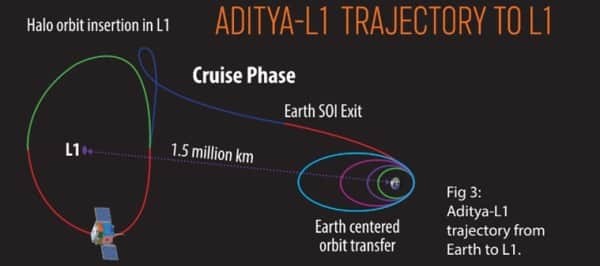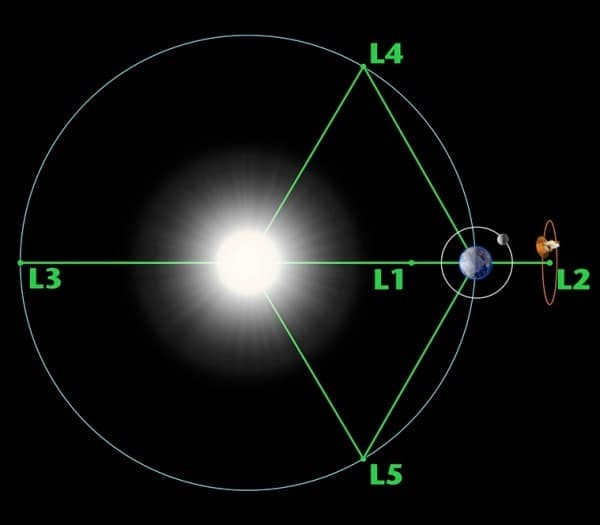Why in news:
The Indian Space Research Organisation (ISRO) has announced that the Aditya-L1 mission, the first space-based Indian observatory to study the Sun, will be launched soon.
About Aditya-L1 mission
- The Aditya-L1 mission will see the Polar Satellite Launch Vehicle (PSLV) carry the 1,475-kg spacecraft to an elliptical orbit around the Earth.
- The spacecraft, which will carry seven scientific payloads, is more than two times lighter than the Chandrayaan-3 mission.
- Like the Chandrayaan-3 mission, the orbit as well as the velocity of the spacecraft around the Earth will be increased till it is slingshot towards the Sun.
- The distance to L1 point will be covered in nearly four months.
- The spacecraft will then be inserted into a halo orbit around the L1 point.
- It will collect data for five years.
What is the L1 point?
- There are five Lagrange points, L1 to L5, between any two celestial bodies.
- These points can act as parking spots in space where the gravitational pull of the celestial objects equals the centripetal force required to keep a satellite in orbit.
- This means satellites placed at Lagrange points do not need to expend a lot of fuel to remain in position.
- Going to Lagrange 1 places the spacecraft at a point beyond the Moon between the Earth and the Sun.
- This offers the spacecraft an unobstructed view of the Sun even during phenomena like an eclipse.
- With the mission covering only 1% of the distance between the Earth and Sun, the payloads will be able to look directly at the Sun.
- The L1 point makes the mission fuel-efficient.
- The Lagrange points are named in honor of Italian-French mathematician Josephy-Louis Lagrange, and there are five of them: L1, L2, L3, L4, and L5.
- NASA’s James Webb Space Telescope is at L2.
- The L1 point of the Earth-Sun system affords an uninterrupted view of the Sun and is currently home to the Solar and Heliospheric Observatory Satellite SOHO.


Objectives of Aditya-L1
- The main objective of the mission is to get a deeper understanding of the star closest to us, and how its radiation, heat, flow of particles, and magnetic fields affects us.
- The payloads on the mission will study the upper atmospheric layers of the Sun called chromosphere and corona.
- They will study the expulsion of plasma and magnetic fields called coronal mass ejection (CME).
- The magnetic field of the corona and the drivers of the space weather will also be studied.
- It might provide clues to scientists about a long-standing mystery that why the not-so-bright corona of the Sun is a million degree C hot, when the temperature on the surface of the Sun is just about 5,500 degree C.
- It will also help scientists understand the reasons behind acceleration of particles on the Sun, which leads to solar winds.
Significance of studying the sun:
- Every planet, including Earth and the exoplanets beyond the Solar System, evolves — and this evolution is governed by its parent star.
- The solar weather and environment affect the weather of the entire system.
- Variations in this weather can change the orbits of satellites or shorten their lives, interfere with or damage onboard electronics, and cause power blackouts and other disturbances on Earth.
- Knowledge of solar events is key to understanding space weather.
- To learn about and track Earth-directed storms, and to predict their impact, continuous solar observations are needed.
- Every storm that emerges from the Sun and heads towards Earth passes through L1.
Payloads of Aditya-L1 mission
- The Remote Sensing Payloads, which will study the Sun, include:
- Visible Emission Line Coronagraph (VELC) for corona/imaging and spectroscopy;
- Solar Ultraviolet Imaging Telescope (SUIT) for photosphere and chromosphere imaging;
- Solar Low Energy X-ray Spectrometer (SoLEXS), which is a soft X-ray spectrometer for Sun-as-a-star observation; and
- High Energy L1 Orbiting X-ray Spectrometer (HEL1OS), which is a Hard X-ray spectrometer for Sun-as-a-star observation.
- The payloads to study the L1 in situ (meaning at their place, or position) are:
- Aditya Solar wind Particle Experiment (ASPEX), for solar wind/particle analyzer protons and heavier ions with directions




